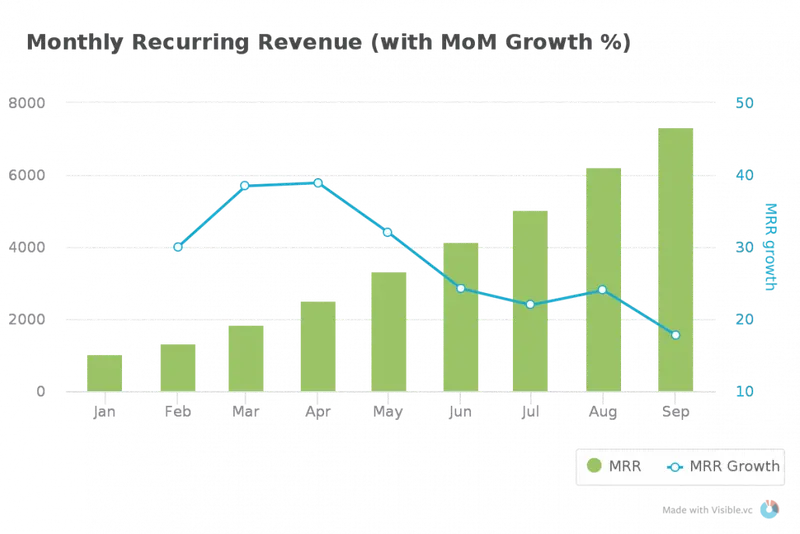
What is the SaaS Business Model?
The typical business model for a SaaS business is a unique and exciting one to dive into. Software as a Service (SaaS) companies are not going away anytime soon and there is much more innovation that will continue to come from SaaS businesses. Looking at companies like Salesforce, Slack, and Zoom (just to name a few), it’s clear that the business model works. But how and why does it work? Read on for a complete breakdown and understanding of the SaaS business model.
SaaS or “Software as a Service” is a delivery model for software where a centrally located, cloud-based software is licensed to its customers via a subscription model. This might be annual, monthly, per user, or by package level but a company can be consider a SaaS company if they are hosting their software on the cloud and licensing it out.
At the core through all of these stages, the business model is based on a subscription payment set-up. This is core to the business and the building block of the model. A SaaS company may offer various types of subscriptions for different products or various end-users, but the subscription model is key to the foundation of the business. Due to the fact that SaaS companies are hosted on a centrally located cloud, they are in a unique position to constantly be updating the software and pushing those updates to users. This update and growth process for SaaS products is much quicker then in-house hardware that used to require very manual processes for the end-user. The subscription model combined with the consistent updates typically present with SaaS products leads to a higher customer retention than other business models. SaaS companies aid this by baking in very high-touch customer success teams to their sales cycle, continuing to work with and serve the customer even after an annual or monthly subscription is committed to.
A SaaS company follows a business model typically goes through 3 phases: early stage, growth stage, and mature stage. All stages involve different levels of funding. For a deeper dive on that specific component, read more here.
Related Resource: 20 Best SaaS Tools for Startups
The early stage of a SaaS company is focused on building out a product-market fit and securing some early, loyal customers. The team is typically bootstrapped or operating on a very small seed or friends and family round. The team typically stays small at this stage as well.
The growth stage in the SaaS business model is focused on scaling extremely quickly by taking on funding via Venture Capital or Angel investors and pushing the limits of your product’s success by taking some risks, scaling the team, entering into incubators, taking on more strategic advisors, and selling up-market. This stage is all about establishing metrics to track success and working to go above and beyond those in order to keep growing the business.
Related Resource: Who Funds SaaS Startups?
The mature stage kicks in when success is proven, the audience is present and hungry for the product, and the focus is now on growing and retaining customers vs. proving out the concept. The focus now can shift to continuing to fine-tune the business via pricing updates, continued product growth and development, and brand building.
Related resource: 11 Top Industry Events for SaaS Startups
Stages of a SaaS Business Model
As we mentioned in our Startup Funding Stages Guide, “There are multiple stages of startup funding: Seed, Series A, Series B, Series C, and so forth. Startups should be conscientious about the funding rounds that they will go through, which are generally based on the current maturity and development of the company.”
The same idea holds true with respects to a SaaS company. A SaaS business model is one of the most attractive to a venture capitalist. The lifecycle and funding stages likely look something like this:
Related Resource: 23 Top VC Investors Actively Funding SaaS Startups
Related Resource: How to Start and Operate a Successful SaaS Company
Seed Funding
Seed funding is a startup’s earliest funding stage. Often, seed funding comes from angel investors, friends and family members, and the original company founders.
Series A Funding
“When a company is first founded, stock options are generally sold to the company’s founders, those close to them, and angel investors. After this, a preferred stock can be sold to investors in the form of a Series A. Series A allows investors to get in early with a business that they truly believe in. It’s a mutually beneficial relationship for both the company and the future stock holders.”
Series B+ Funding
“Once a business has been launched and established, it may need to acquire Series B (and beyond) funding. A business will only acquire Series B funding after it has started its operations and proven its business model. Series B funding is generally less risky than Series A funding, and consequently there are usually more interested investors.”
Important SaaS Business Model Metrics
While diving deeper into the SaaS business model, it’s important to understand the key SaaS metrics that will inevitably pop-up along the way. These key SaaS Metrics are critical to track in order to understand the health of a SaaS business.
MRR (Monthly Recurring Revenue)
Not to be confused with ARR (Annual Recurring Revenue), MRR is how much money your company can be expected to bring in every month. Going beyond the basic meaning, MRR is a functional metric through which you can gauge your company’s income and success. MRR growth equals business growth – the same goes for shrinking MRR most likely equaling a negative impact on the business. MRR trends are incredibly important to subscription-based businesses, because they compound over time.

CAC (Customer Acquisition Cost)
The sum total it takes for your team to acquire a customer. This includes the time of the sales reps but also the marketing dollars spent. Tracking your customer acquisition cost tells you a lot about how your company is operating. If the dollars and time spent to acquire a single customer is higher than the MRR or ARR that customer brings in, that can be a huge red flag for the business. Over time, your customer acquisition cost will also tell you whether it’s getting more difficult or easier to acquire new customers. You’ll be able to look at trends to see when acquiring customers becomes more affordable, and if there are specific seasons during which customer acquisition is more expensive.

LTV (Lifetime Value)
Here at Visible, we consider LTV of a customer to be the most important metric you can track. LTV is the average customer revenue multiplied by the gross margin percentage divided by customer churn rate. Another way to think about it is MRR or ARR X Customer Lifetime. Understanding LTV is important in assessing the overall health of your company as well as justifying CAC costs to your investors. Some good news as you’re starting your business – you can track CAC and LTV right in Visible.
Churn
Essentially, churn is loss. You can have customer churn – the number of customers that cancel their subscription to your business annually or monthly. You can also have revenue churn – how much money is lost annually or monthly. Churn is expected in most businesses but maintaining an acceptable rate in comparison with the growth of your business is a key metric to understand, measure, and track. You can accept about three to five percent of your small to medium sized businesses portfolio every month or less than 10 percent annually. As enterprise level businesses go, aim for a churn rate less than one percent. Your churn rate should continue to decline in subsequent years until you reach negative churn.
Customer Retention
This SaaS metric refers to how long you are able to maintain a customer per your subscription model. This could be annually or monthly. Healthy retention can also be customer growth. If a software is user-based or has multiple product components, upsell and expansion can be possible leading to annual retention exceeding 100%. Healthy customer retention may not mean you maintain every customer every year, but you ultimately are seeing growth in the business through a balance of renewals, upsells, and contract expansions.
Successful SaaS Business Model Examples
There are thousands of SaaS businesses in the world today with more growing every year. Despite the model being a popular and growing business practice, 93% of SaaS startups fail within the first 3 years due to a lack of product market fit, run into cash flow problems, or experience more churn than growth. Diving into a few examples of successful SaaS businesses can be a helpful way to better understand the business model.

Salesforce is one of the most recognizable SaaS companies and was a true Trailblazer in the space. You can read a brief history of the business here. Salesforce has been so successful because it was one of the first companies to truly implement the SaaS Business Model successfully and has intelligently scaled by continuing to not only update it’s products, but by acquiring products where they see new opportunity effectively retaining customers and upselling them into new products as well as constantly expanding out into serving new industries. They are a mature company now with roughly 30,000 employees globally and a heavy focus on customer story-telling and partnership as a way to stay top of mind in the SaaS world.
An extension of the SaaS model that has emerged and has proven to be successful is the “Freemium” model. This pricing structure allows a portion of the product to be used for free by a user or team with full features being available through a subscription. This model works because it allows users and teams to get hooked on a product, have a positive experience with it, and share it internally and externally. This model is a good way to prove product-market fit and keep CAC down by having the product and its use take on a viral aspect with customers being bought in to a point that when the ask comes in to purchase the full software, the education that typically happens around a sale has a lot less friction associated with this.
Two companies with extremely successful Freemium models are Slack and Zoom. Both tools can be used for free by individuals, teams, and even larger organizations but have limits on things like storage, meeting times, and seat #s that are only available when an enterprise package is purchased.
Pros & Cons of a SaaS Business Model
Like any business model, there are of course pros and cons to diving down any particular path.
Pros of a SaaS Model
- Rapid growth – if you find product-market fit early and are able to secure funding, the possibility of growing your company to a Billion dollar valuation is very real and can happen extremely quickly.
- Ease of deployment – because SaaS lives in the cloud, it can be easy to make quick fixes to your product and sell to and serve customers from virtually anywhere.
- Predictable revenue – the subscription model affords you the ability to fairly consistently understand how much money you can expect to make. There is no seasonality in a subscription model and annual or monthly contracts provide security that many other business models cannot guarantee.
Cons of a SaaS Model
- Upfront costs – If you aren’t able to secure funding right away, it can be tough to maintain the capital and manpower needed to grow your company quickly enough to be successful. It’s common to not see profitability in the first few years, so it can be a hard business model to follow by truly bootstrapping. Specifically the cost of a team, CAC, and cost to build out the infrastructure to host your cloud software are major factors to consider.
- High risk – growing fast also means you can fail fast. Taking on a lot of capital and scaling quickly can bring reward but if something changes in the market, your business could crash and burn overnight.
- Churn – although revenue may be predictable, if the wrong combination of events takes place in a year (major competitor comes to market, market needs change, economic changes occur), you may see a huge bout of churn in a renewal cycle. This extreme shift could be almost impossible to bounce back from.
SaaS Business Model Growth Strategies
In addition to the “Freemium” model shared above, there are many other growth strategies that can be implemented in a SaaS Business model. A few popular ones include:
Customer Stories and Referrals
If your SaaS is integral to the way a company does business, you may be lucky enough to have customers who are super fans and love advocating for the value you bring to their day, their work, and their business. Capitalizing on these success stories through marketing content, speaking events, or even referrals can be a smart way to grow your business in an authentic way. These customer stories are good proof points to why you work. Referrals can often lead to better conversations earlier on with prospective customers or even help your sales team break into accounts that have been historically tricky to sell to. Here is an example from one of our customers:

Thought Leadership
If your company is selling into a specific space, a common strategy is to try and become the “expert” in that space. If your company blog or community group can provide value to your end-user outside of your product, that credibility will spread. Lattice does a great job of this. They have built a free 10k plus HR community group for any HR leader. They keep this space completely focused on their ultimate end-user but never focus on the product, simply provide a space for that community to meet. From there they are able to source content and ideas on what to write about in their blog and share on their podcast, effectively providing value to their end-user before even attempting to make the sale. This name recognition and “expert” status makes the use-case for the product feel more in-line with what the user group is actually interested in.
3rd Party Resources
Companies that actively spend time building up great customer reviews on sites like G2.com or work to be analyzed for trusted reports like Forrester, can use that credibility as an outside proof-point for why their product is valuable when selling into new customers.
Social Media and Influencer Marketing
This strategy is all about going where your end-user is. Build a brand and a voice via social media sites that are popular with your customer. Showcasing your companies voice and personality as well as commenting and sharing insight into trending topics can be an easy way to grow your awareness in an industry. Influencers, or well-known folks in a specific space, can be valuable on social media as well. If a top marketing influencer endorses your marketing SaaS software, folks may come inbound based on that person’s recommendation. Connecting with and offering trials to influencers can be a great way to get this started. Additionally, identifying an exec at your company with a strong following can be a great way to build your company brand via that individual. Folks on LinkedIn, for example, are much more likely to engage with what a person has to say then what a branded company page does.
Tools to Help You Optimize Your SaaS Business Model
We recommend a few tools to start when jumping into a SaaS business model. Free or premium versions are great, but it’s important to invest in tools that allow you to measure the key metrics listed above and track overall business health.
CRM – A customer relationship management tool is key to maintaining an accurate and complete data-base of all of the accounts your team is actively selling to, are active customers, or who have churned. A complete picture of the relationships your company works with will allow you to measure growth and track CAC, MRR and churn. Salesforce, Hubspot, and Oracle all offer quality options but starting out you can build a basic CRM via spreadsheet tools – it will just be a lot more manual.
Analytics Tool – Invest in a tool that will allow you to accurately measure all the metrics for your company. We recommend google analytics or manually tracking your metrics via a spreadsheet tool if you don’t have the budget to invest right away. Looker and Tableau are great options once you have budget to spend.
Visible – We of course have to share how we can help with growing our SaaS business model, too. Once you take on funding, we are the most complete tool for sharing updates with your entire team and managing existing and potential relationships with investors. You can learn more and check out a free trial of us here.




